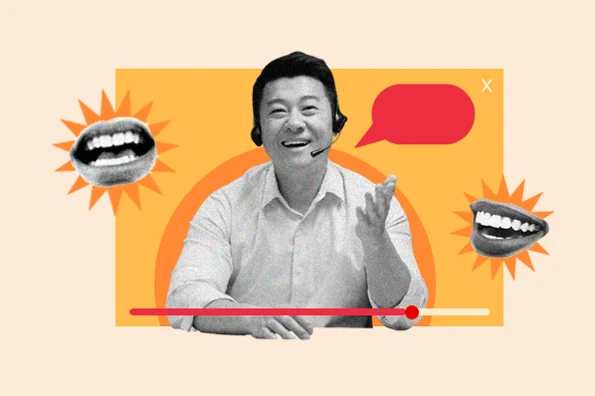In this article, I’ve compiled 40+ customer service training ideas to help optimize your training and provide inspiration for reps looking to up their customer service game. Read on to start moving the customer service needle!
Table of Contents
- Customer Service Training Topics
- Customer Service Training Exercises
- Customer Service Training Ideas
- Customer Service Training Tips
- Customer Service Ideas for Reps
- Customer Service Training Your Team Will Love
Customer Service Training Topics
- Reflective Listening
- Product Demonstration
- Call Review
- Customer Service Training Presentations
- Sensitivity Training
- Customer Experience Simulation
- Social Media Training
- Product Breakdowns
- Corporate Culture Training
- Crisis Communication
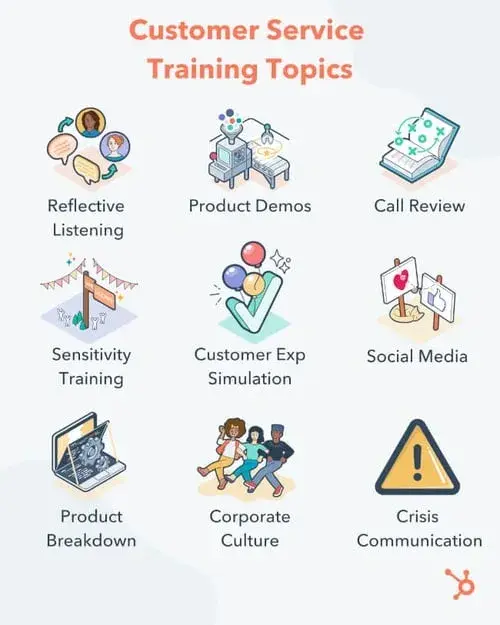
1. Reflective Listening
Reflective listening is a communication technique involving actively listening to someone and repeating what they said. Doing so confirms that you understand what the other person is saying and shows you are committed to helping. In customer service, reflective listening is essential for demonstrating empathy, reducing conflict, and moving conversations toward success.
Pro tip: In my experience as a customer service rep, I learned that reflective listening is essential, especially when customers aren’t clear about their issues. By paraphrasing concerns in my own words, I could reduce misunderstandings and ensure that the customer and I were on the same page.
Why I like it: Reflective listening makes customers feel heard, understood, and valued. It sets a positive tone for customer service interactions that can transform a difficult case into a collaborative problem-solving session between you and the customer.
2. Product Demonstration
Product demonstrations are a way to test reps’ knowledge of your product and its features. During my training at HubSpot Support, I did my share of product demos, forcing me to gain comprehensive and actionable product knowledge.
“If you can’t explain it simply, you don’t understand it well enough.”
Albert Einstein said that, but it might as well have been my old support manager. Customer service reps must have deep product knowledge, but the key is communicating that knowledge succinctly and clearly. Product demonstrations help with that.
Pro tip: Have reps prepare a 10-15 minute product demo as though they are presenting to a prospective customer. Make sure they don’t just regurgitate product features without truly understanding them.
3. Call Review
Call reviews are common among successful customer support teams, and I’ve been on both sides of them as a new hire and team lead at HubSpot.
Periodically, teams should gather to listen to a recorded call with a customer and discuss what went well and what needs improvement.
Pro tip: Actual calls give you insight into real customer expectations. Along with input from team members, you can gather unique perspectives on helping reps improve.
Why I like it: I have found that listening to calls with someone over my shoulder makes my areas for improvement extremely clear.
Featured Resource: Customer Support Training Template
4. Customer Service Training Presentations
There’s nothing like a classic presentation to train support reps and encourage discussion. Just make sure you don’t put your team to sleep!
Here are some presentation formats to consider:
-
Visual. Use short video clips and infographics to demonstrate concepts or examples.
-
Storytelling. Share stories and experiences of customer interactions to connect with support reps and show them how to overcome challenges.
-
Instruction. Clearly state the what, why, and how of a new or complex topic. Use analogies to make complex topics easier to understand by connecting them to something relatable.
-
Q&A. Hold open sessions to foster engagement with your team and learning through discussion.
Pro tip: An excellent presentation seamlessly combines most or all of the above formats.
5. Sensitivity Training
Sensitivity training helps team members understand their unconscious biases and respect one another’s differences, which is crucial in a diverse working environment like the one I had at HubSpot Support. Conduct sensitivity training regularly to prevent harassment, foster empathy, and create a healthy, collaborative working culture.
Pro tip: Interactive activities like discussions and role-playing can effectively demonstrate concepts in sensitivity training.
What I like: Sensitivity training creates a more inclusive and supportive work environment, which benefits the customer in the long run.
6. Customer Experience Simulation
Customer experience simulation is a role-playing exercise in which reps assume the role of a customer and experience all the steps of purchasing your product or service (or resolving a support issue) from the customer’s perspective.
This exercise benefits reps by allowing them to see the roadblocks from the customer’s perspective. Reps can relate to customers’ frustration or disappointment when something goes wrong or their expectations aren’t met. Thus, when working with real customers, reps better understand what people are going through and how to resolve their issues.
Pro tip: Run simulations for each of your key customer personas. This will ensure that your team understands your varying customer needs and experiences.
Why I like it: Having been both a customer and a customer service rep, I can attest that there’s no better way to build customer empathy than to walk a mile in their shoes.
7. Social Media Training
Customers expect excellent customer service from brands on social media channels. As the expectation of omnichannel support becomes the norm, nearly half of consumers say they'll unfollow a business on social media due to poor customer service. I’ve experienced this myself, so investing time and training resources is crucial to equipping your reps for social media support.
Pro tip: Use a social media management and listening tool to track brand mentions, manage response times, and organize an inbox of social media support queries. This will ensure that no customer inquiry goes unaddressed.
8. Product Breakdowns
For physical products, perform live product breakdown sessions to show your team members how the product works. Disassemble the product, explain each component, and discuss the manufacturing process from sourcing materials to assembly.
For software products, ensure employees know about your system architecture, server locations, and all recent updates. Discuss contingency plans for potential shutdowns and what employees can share with customers if they ask about sensitive information.
When I worked at HubSpot Support, we often received support calls from IT professionals. Speaking their language and relaying relevant technical details delighted these customers and made them feel well cared for.
Pro tip: Set up regular Q&A sessions with product team members. Encourage open communication between support and product teams so everyone stays updated on the latest changes and developments.
9. Corporate Culture Training
Service is the primary customer-facing team of most organizations, so it is paramount that they understand and reflect your company culture. Working at HubSpot, I was influenced by their strong customer-centric culture, which consistently prioritized customer needs and empathy.
As a customer, I can tell if a customer service rep is genuinely invested in my success or just wants to close my case. That difference comes down to culture.
Corporate culture training doesn’t have to be extensive, but it should be consistent. Employees should be immersed in your company’s core values and how they contribute to that culture. Use real-world examples and brief interactive sessions to demonstrate your organization’s core values and how they should be reflected in customer interactions.
Pro tip: Create a culture code that clearly outlines your values and expectations of your team.
10. Crisis Communication
In my experience, how a company handles a crisis can make or break customer relationships. Effective crisis handling is honest and transparent, reassuring customers that everything is handled properly.
Successful companies don’t wait for a problem; they anticipate it and prepare their teams accordingly. Being proactive in crisis communication ensures that reps can confidently handle high-pressure situations.
Pro tip: Create a crisis communication plan so every rep is educated and prepared to handle challenging situations and field questions that customers are likely to have.
Customer Service Training Exercises
- Mock Calls
- No No’s Allowed
- Role Playing
- Lunch and Learn
- Meditation
- Personality Tests
- Call Your Competitor
- Employee Testimonials
- Attitude Anchors
- Customer Letters
Customer service teams are busy, and you may not have time to host formal training regularly. However, this doesn’t exclude your team from performing activities that can help them sharpen their skills.
Try the exercises below to improve your customer service skills.

1. Mock Calls
Like reflective listening exercises, mock calls are a time-tested strategy for practicing a job before actually doing it.
Team members should be paired up and given real scenarios that customer support reps must tackle daily — easy and difficult. Have support reps take turns serving as the customer and the support rep so they can get an idea of how to handle common issues and adapt during stress-inducing calls.
Pro tip: Challenge your team members by asking questions about new features and notoriously tricky case types.
2. No “No’s” Allowed
Train reps to reframe customer questions towards solutions-oriented responses, even when the real answer is “no.”
In a “No No’s Allowed” exercise, instruct reps to avoid saying “no” or similar negative phrases like “I can’t help with that” or “I don’t know.” Pair up team members and have one play the customer and the other play the support rep. Have the “customer” make bold, difficult requests that challenge the support rep to offer helpful alternatives instead of flatly refusing.
Here’s an example:
- Customer: “My CRM is way too expensive. I need you to give me a discount.”
- Support Rep: “I understand you’d like to cut down the cost of your CRM subscription. I can help you consolidate and clean your database to under 1,000 contacts, which will bring the price down a bit. Would you like me to help with that?”
Why I like it: This exercise promotes creative problem-solving and teaches reps to approach even the most challenging situations with a positive tone.
3. Role Playing
Role-playing is an effective exercise for sharpening customer service skills. One employee pretends to be a customer and then presents a service case for another to troubleshoot. Once the case is solved, reps switch places and repeat.
Role-playing lets reps work on both communication skills and their troubleshooting process. Since it’s not a real customer, reps have a safety net that allows them to practice new techniques. If your team works with customers face-to-face, this exercise gives them a live environment to perfect their skills without risking customer churn.
Pro tip: Track scenarios and question types that tend to trouble reps and incorporate them into role-playing scenarios to help them build confidence.
4. Lunch and Learn
They call it a support team for a reason.
Strengthen team dynamics and morale through lunch and learns, where team members take turns giving presentations and leading discussions during a scheduled group lunch. It doesn’t matter what topics the reps choose to present. What’s important is strengthening team bonding and giving reps experience with presenting and explaining new topics to others.
What I like: Lunch and Learns are a fun way for reps to build the critical skills necessary for explaining concepts to customers with clarity and confidence. When I worked at HubSpot Support, I found lunch and learns helpful in creating a safe team environment where I felt comfortable collaborating with my colleagues, which benefits the customer in the long run.
5. Meditation
Sometimes, working on the front lines of customer support can be stressful.
No matter how hard you try, sometimes you might get the blame for a problem that’s entirely out of your control or even receive unkind words from customers. It sucks, but it happens.
I’ve found meditation to be a helpful tool for regulating my emotions and regaining objectivity and mental clarity, especially during challenging times. If you can’t step away from your desk for an entire mediation session, I find it very helpful to just check in with myself and focus on my breath for a few moments. A long inhale followed by a short breath hold and an even longer exhale relaxes me in just a few seconds.
Pro tip: Apps like Headspace are helpful for guided meditations and those new to mindfulness. They also offer business plans that allow all your employees to access mindfulness resources.
6. Personality Tests
New reps should take a personality test to learn how they work and communicate best with others.
One framework you can use is the DiSC profile, which evaluates people’s behavioral and personality differences. Here’s an example profile below.
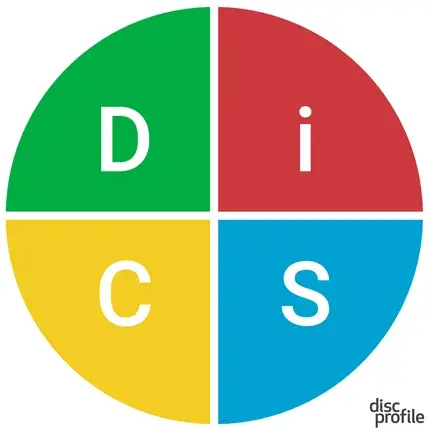
Other tests include the Myers-Briggs Type Indicator (MBTI) and the Predictive Index Assessment (PI). All of these can give support reps helpful insights into how they work best, communicate with others, and possible sources of conflict they might encounter.
You can’t control the customer’s personality — but you can control your reactions and responses. Learning the “why” behind your actions is an excellent first step.
Pro tip: Personality testing is excellent for sparking discussions at lunch and learns. It is also helpful for management to understand employees’ different personalities and learning types to personalize guidance and mentorship.
7. Call Your Competitor
Have your team call your competitor’s customer service line to learn about the competition. If possible, purchase one of their products or start a free trial.
Ask routine questions and pay attention to details during the call, such as the rep’s tone, cadence, ability to provide an answer quickly, and the type of follow-up options they offer. These interactions will set the standard that your team must surpass.
Pro tip: Have senior team members or management screen the calls and create a debriefing process so reps can share insights and areas for improvement.
8. Employee Testimonials
Your most experienced reps are some of your team’s most valuable resources. They’ve seen your product and company grow with its customer base and have been present for all the speed bumps and roadblocks. Use their stories as testimonials for how your new reps should treat customers.
Pro tip: In my experience, demanding customers and crisis scenarios create the most substantial teachings. Use testimonials to showcase how your team creates delight out of even the most challenging situations.
9. Attitude Anchors
Attitude Anchors are actions reps can take to maintain a positive attitude at work or reset after a difficult call.
Pro tip: Encourage your team to brainstorm two types of anchors: maintenance anchors and repair anchors.
Maintenance Anchors
These actions help reps maintain a positive mindset throughout the day. Some examples include:
- Spending time with friends and family.
- Getting enough sleep.
- Exercising regularly.
- Practicing mindfulness.
Repair Anchors
These actions help reps emotionally reset after difficult interactions. Examples include:
- Taking a walk outside after a challenging call.
- Using positive affirmations like “I did my best, and I am proud of myself.”
- Talking to a trusted coworker, friend, or family member.
Pro tip: Once you’ve created a list of attitude anchors, hang them up in a visible area so reps are encouraged to take these actions when needed during the workday.
10. Customer Letters
If reps feel undervalued by your customers or upper management, try having them write customer letters. These are letters written from a customer’s perspective and addressed to the customer service employee. Encourage them to reflect on their interactions with customers and write a letter as if they were the customer, expressing gratitude for the support they received.
What I like: It’s easy for support reps to lose perspective of the impact of their work and feel like their efforts go unnoticed. I know this from experience. Writing customer letters reminds reps of the value they bring to customers and the business.
Pro tip: Encourage reps to reflect on specific moments where they went above and beyond to help customers.
Customer Service Training Ideas
- Shadow support calls.
- Review customer service standards.
- Use microlearning for quick training.
- Practice being a good customer.
- Conduct rapid-fire product Q&A.
- Host scenario discussions.
- Show rather than tell.
- Review knowledge base materials.
- Start a mentorship program.
- Request feedback.
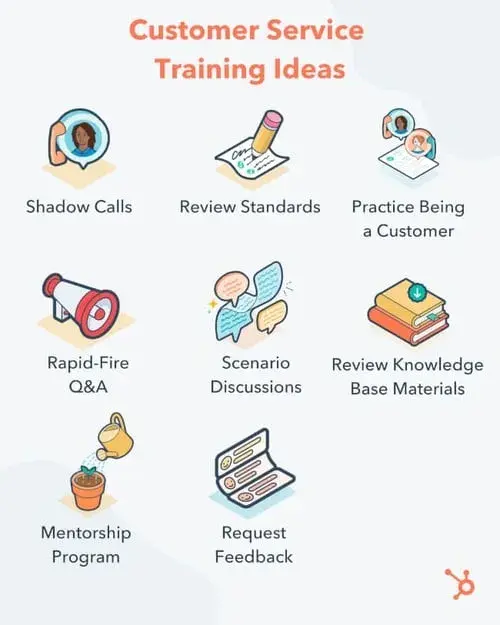
1. Shadow support calls.
Shadowing support calls is a fantastic method for giving new reps experience and insight into handling customer support requests. As a former support rep, I can tell you that it is a crucial step before taking the training wheels off.
By observing experienced reps on the job, new reps will learn:
- The most common types of customer inquiries and concerns.
- Successful communication strategies.
- How to manage customer expectations.
- How to adapt their tone and cadence based on the customer.
Pro tip: Additionally, experienced reps and managers should shadow new reps on their first few calls. That way, they can provide constructive feedback and adapt the onboarding experience.
2. Review customer service standards.
Maintaining your company’s customer service standards is crucial, but unfortunately, it’s easy for those standards to dip, especially during periods of high volume when reps are stressed.
Regularly reviewing customer service standards ensures consistency and reinforces the importance of delivering high-quality service. If you set your reps’ quotas too high, the quality of service may dip as the focus shifts to closing as many cases as possible.
Pro tip: Some strategies for keeping your reps up to date on service standards include:
- Daily automated Slack messages to share reminders and quota updates.
- Weekly emails to celebrate wins and call out instances of reps providing exceptional service.
- Stand-up meetings to discuss strategies for upholding standards and any new expectations or updates.
3. Use microlearning for quick training.
Microlearning breaks down employee training into manageable chunks, helping reps learn and apply teachings quickly. Short training sessions encourage service reps to participate and retain more information.
Pro tips:
- Keep it short and focused, ideally no longer than 10-15 minutes per module.
- Use videos, infographics, and quizzes to keep it engaging.
- Use a mobile-friendly platform so reps can access training anytime, anywhere.
4. Practice being a good customer.
A great way to improve your customer service game is to recognize excellent customer service firsthand. In my experience, being a good customer begets good customer service. As a former support rep, I always treat customer service representatives with kindness and respect, and they almost always return the favor.
Pro tip: Note the small details when you have a positive service interaction. What did the rep do to make you feel good about the interaction? Consider details like tone of voice, eye contact, and the overall friendliness of the interaction.
5. Conduct rapid-fire product Q&A.
A great customer service rep knows their product like the back of their hand. Testing this knowledge with trivia-style questions can be a fun and competitive way for the team to participate in customer service training.
Pro tip: Consider small incentives or recognition of Q&A champs to boost motivation and encourage reps to brush up on their product knowledge.
6. Host scenario discussions.
Scenario discussions are a fun and collaborative way for teams to apply product knowledge and put their problem-solving skills to the test.
How it works:
- Concoct several customer scenarios, each highlighting a specific problem or product area.
- Divide your team into smaller groups and task them with discussing potential solutions.
- Bring everyone back together and have each group present their solution to the customer scenario.
What I like: Scenario discussions boost team morale and collaboration. Working with teammates on how to best help customers is a great icebreaker that will get reps feeling more confident and comfortable in the workspace.
7. Show rather than tell.
Did you know 95% of employees prefer video-based training over text? Coupled with the microlearning insights from earlier, I think it’s clear that video should play a significant role in your service training strategy.
Make it visual: Demonstrating a multi-step process via a short video clip is much more effective than sending a hefty email with multiple steps and screenshots. Make it easier for yourself and your team, and lean into video training as much as possible.
Pro tip: Use a tool like Loom to create screen recordings and video messages to walk your team through on-screen processes. You can even record a voiceover to accompany your video for extra clarity.
8. Review knowledge base materials.
Most customers solve their problems using self-service options before calling or emailing your customer service team. I’m one of those customers. I’d much rather solve the problem by skimming a knowledge base article alone.
Accordingly, you should regularly review your knowledge base materials to ensure they are up-to-date and helpful. Your team should also review the materials to familiarize themselves with the available resources to send to customers. As a support rep, I always had a few knowledge base articles on deck that I sent to customers daily.
Pro tip: Create a process where your team members can report inaccurate or outdated information on your knowledge base.
9. Start a mentorship program.
You can’t be everywhere at once as a manager, so use your team’s experience to foster continuous learning through a mentorship program.
By the end of my tenure at HubSpot, I became a Support Team Lead. As an experienced support rep, I was matched up with a group of two new hires and tasked with mentoring them, shadowing calls, and being a resource as they learned the ropes of customer support.
What I like: A mentorship program fosters a supportive team atmosphere. The new hires I mentored became my closest friends at the office. In addition, a mentorship program is an excellent track for reps interested in growing their careers and potentially moving into a management role.
Pro tip: Schedule regular meetings with mentors to discuss their mentees’ progress and flag any challenges or areas that need attention.
10. Request feedback.
Gather feedback after each training session to assess the effectiveness of the content and delivery. Use this information to continuously improve your training, making it more engaging and successful.
You can collect feedback data quantitatively through a rating system or qualitatively through an open-ended survey. No matter the format, receiving feedback on your training program is a primary way to improve it so your reps can do their best work.
Pro tips:
- Keep surveys brief, share the results with your team, and outline the actions you plan to take based on their feedback.
- Offer an anonymous survey option to ensure honest feedback, especially for sensitive topics.
Next, we’ll discuss some tips for making customer service training more effective and “sticky.”
Customer Service Training Tips
1. Start with a mission.
Clearly define the vision of how your organization approaches customer service. Ensure your team sees the big picture, and each member understands their role in the larger goal of customer success and delight.
Pro tip: Craft a mission statement that defines your customer service vision. Display that mission statement in common areas and incorporate it into training materials so it remains top-of-mind.
2. Double down on communication training.
Customers don’t simply want their problems solved; they want to be heard. Practicing active listening and communication techniques is paramount to delivering great experiences, and by cultivating these skills among your team, you’re setting them up for success.
Pro tip: Invite customer service or communication experts to give talks and share best practices with your team.
3. Make training fun and engaging.
People learn in different ways. There are visual learners, auditory learners, kinesthetic learners, and more. That means that sitting new employees down in front of a training video will not be enough for maximum retention and, even worse, could result in a snooze fest.
To make your training effective, you must engage your reps. This can be done with interactive elements designed to keep them on their toes and interested in the material. Don’t be afraid to have fun with it, either.
Pro tip: Use gamification to make training a fun, lighthearted competition that will motivate reps to soak up knowledge.
4. Connect training to real-life scenarios.
Use role-playing, shadowing, and other real-life scenarios to get reps comfortable with the reality of their day-to-day expectations, which is working with real customers.
Pro tip: Always circle back at the end of training to demonstrate how exercises directly relate to daily operations.
5. Emphasize the process.
A familiar process will help new reps gain confidence, especially in unfamiliar situations. Provide a consistent, step-by-step process for handling customer interactions to empower reps to tackle challenges head-on.
Pro tip: A process is not the same thing as a script. I don’t recommend making your reps regurgitate specific phrases without knowing what they are doing.
6. Supply robust internal resources.
Your employees deserve a knowledge base, just like your customers do. To ensure reps have access to necessary internal knowledge and resources, use a well-organized, well-maintained internal knowledge base.
Pro tip: Work on crafting a culture where finding answers independently is valued, and train reps to locate internal resources effectively.
7. Provide ongoing training.
Training is never a one-and-done thing, especially in customer service. To ensure reps keep their skills sharp, incorporate continuous education with microlearning and short refresher courses.
Pro tip: Track your team’s performance and metrics over time to identify areas for improvement and topics for future workshops.
Customer Service Ideas for Reps
1. Put yourself in the customer’s shoes.
If you have the opportunity to use your company’s product, you should take it. When I worked in HubSpot Support, I used my HubSpot portal to build a personal blog and a CRM for my side hustle (now my main hustle).
The hands-on experience I gained from using the product myself was invaluable in building expertise and, more importantly, empathy for customers as they tackled challenges I was familiar with. There’s no substitute for getting your hands dirty; having some skin in the game accelerates your product knowledge and benefits the customers you interact with.
2. Crack a smile when talking to customers on the phone.
It may seem silly, but in my experience, smiling sets a positive tone customers can feel, even if they can’t see your face.
During my time in customer support, I intentionally brought a friendly, bright, helpful attitude to my interactions with my customers. After a while, I realized I was always smiling when I picked up the phone. It wasn’t even on purpose, but it’s nearly impossible not to smile when you’re trying to be kind and helpful. So, if you’re having an off-day or just working on developing your customer service voice, try showing off those pearly whites through the phone!
3. Anticipate your customers’ needs.
The difference between good and great customer service is helping your customers succeed, not just solving their problems. In my experience, anticipating customer needs and offering tips and hacks for success with your product is a recipe for delight.
Be proactive: If you notice a feature your customer hasn’t taken advantage of or a way to optimize workflow, let them know! Customers will appreciate the collaborative effort.
4. Address customers by name.
When communicating with customers via chat, email, and especially over the phone, address them by name. Everyone likes hearing their name. Our brains are naturally wired for it. Hearing your name elicits an emotional response of recognition and validation.
When working with customers, addressing them by name strengthens the personal connection between you, them, and your brand. This simple gesture makes them feel special and well taken care of.
Outside of blog post writing, I’m a professional bassist. When I show up at a gig, and the sound engineer makes an effort to learn and call me by name, it immediately puts me at ease and makes me feel confident that everything will go smoothly. That’s how you want your customers to feel whenever they touch base with your business, so don’t be a stranger and call them by their names!
5. Admit your mistakes.
Embrace Authenticity:
Everybody is human, and we all make mistakes. If you or your company makes a mistake when dealing with a customer, own up to it, apologize sincerely, and reassure the customer of your dedication to their success. You know what they say: honesty is the best policy. Customers will appreciate it if you display authenticity and honesty, especially in a difficult situation.
Don’t Fear the Customer:
People (customers) are generally reasonable. If you are upfront and honest when issues arise, 99% of the time, customers will be understanding and patient. I’ve found that customers’ emotions only tend to flare when met with deflection and vagueness.
6. Show and tell.
When working with customers, you typically type out a paragraph or explain something verbally over the phone. Usually, that’s the way to go. However, sometimes you need to detail a multi-step process or explain a complex feature.
Get Visual:
Consider sending detailed, annotated screenshots and screen recordings to help explain concepts to customers. You can even record audio over your screen recordings to narrate all the steps of a process. This is especially relevant if you support a software product or help customers navigate a web portal.
When I worked in customer support at HubSpot, I would often screen share with customers to visually walk through more complex processes. Not only is this a time-saving measure, but it sets the customer up for success with your product as they will be better equipped to help themselves in the future.
7. Reward loyal customers.
There’s nothing quite as exciting as a free gift or a discount, especially if it’s a surprise! Consider surprising your most loyal customers with a discount code to show them you care.
Example: I recently received a complimentary dish from my favorite local tapas restaurant just for being a regular customer. I’ll tell you what: All it took to go from loyal customer to evangelist was some patatas bravas.
8. Send handwritten thank you notes.
Hardly anyone writes letters anymore. Why would you? You can send an email or a text to get your point across.
Make it personal: Make customers feel special by thanking them the old-fashioned way. Surprise your best customers with a handwritten note showing gratitude for their continued support.
Example: I run a musical instrument rental company, and whenever I send out an amp or a guitar, I sneak in a little handwritten note thanking the customer for their business. It’s a nice touch that makes customers feel good about doing business with you.
9. Make your support as fast and easy as possible.
Show customers you appreciate them by valuing their time.
Time is money, and everyone is strapped for it these days. Strive to make your response time as quick as possible. Use tools like email templates and automated chatbots to streamline the customer service experience as much as possible while retaining a personal touch.
I recently had a customer service experience where they resolved my issue in the first email reply, which arrived less than two hours after I submitted the request. I was thrilled, and I guarantee your customers will be, too, if you can solve their issues efficiently and with care.
10. Offer social media support.
Customers often contact brands on social media when seeking an almost immediate reply. Ensure you can handle these requests with a dedicated social media support team or representative. Focus on clear, quick replies, and be ready to move the conversation off the platform if necessary.
Make it quick: Customers often use social media to lodge public complaints about a brand. If you are in that situation, reply quickly (ideally within 24 hours) and employ an empathetic, helpful tone. It is also best practice to move the conversation from a public thread to DMs.
I was a member of the Twitter support team during my time at HubSpot. Not only did we respond to questions when we were directly tagged, but we also used social listening software to discover opportunities for proactive support.
11. Actively listen.
Active listening can be the difference between a decent customer support experience and an exceptional one.
Active listening is more than just hearing what your customer has to say. It’s about fully understanding the message the customer is portraying and empathizing with them. You must give your full attention to customers to understand their needs and respond appropriately.
Listen to understand, not to respond:
In my experience, actively listening to customers makes them feel valued, heard, and understood. You can practice active listening by paraphrasing. Listen closely to what your customer says and reiterate it to them in your own words. This will help you clarify their needs and ensure you are both on the same page.
12. Take a look in the mirror.
Keep a mirror somewhere on your desk and glance at it while you’re on the phone with customers. The mirror won’t lie about whether you’re actively engaged. It will serve as a reminder to maintain a smiley, positive attitude on the phone. It also dramatically reduces the chances of getting caught with spinach between your teeth after lunch.
13. Help customers help themselves.
Some customers want you to solve their issues and get on with their day. That’s cool. However, some customers prefer to help themselves. You can facilitate that by offering an extensive knowledge base and directing customers towards relevant articles.
The Power of Helping Yourself:
I’m one of those customers who likes to help themselves. Learning to handle a problem independently empowers and excites me to continue using a product or service.
14. Give out some swag.
Everybody likes swag — fun branded items you can give customers for free. Think t-shirts, phone cases, stickers, pens, coasters, and more. The more creative you can get with swag, the better. Consider giving free swag to your most loyal customers, customers who worked through a difficult issue with you, or even including fun freebies in the box with every item sold.
Personal favorite: My favorite piece of swag is a free t-shirt from Huel in 2017. It’s a plain gray tee with the Huel logo on the front, but something about the fit is just spot on. It’s been my go-to workout shirt for years now. So, invest a little extra in your swag, and you may end up with a whole division of free brand reps!
15. Stay positive.
It’s not what you say but how you say it.
Maintaining a positive attitude and tone is crucial to success as a customer service representative, especially when confronted with difficult situations and frustrated customers. Positive language and an optimistic outlook can be the difference between customers coming away from an interaction disappointed or singing your brand’s praises.
Pro tip: Maintaining positivity can be challenging, especially when work piles up and life gets stressful. For me, gratitude is key. Try adopting a morning meditation routine to stay balanced throughout the day. I like to pair my meditation with a few yoga stretches; before you know it, my glass is half full.
16. Use customer service templates.
While personalization is key to high-level customer service, that doesn’t mean you can’t use templates to streamline your responses. Consider using email and chat response templates to save time typing things like greetings, introductions, and sign-offs.
I use HubSpot templates for my business to streamline my customer service and sales outreach emails, and the amount of time saved adds up!
Customer Service Training Your Team Will Love
Outside of team meetings, there are plenty of online resources that customer support and service reps can use to keep improving. Whether your customer service team is short on time or completely remote, these topics, tips, and ideas will excite and motivate your reps to deliver top-notch service. A mix of interactive, team-oriented, and role-play activities will keep training enjoyable for your reps so they understand and remember the information.
If you’re ready to plan your next customer service training session, use the template below to get started.
Editor's note: This article was originally published in June 2018 and has since been updated for comprehensiveness.
.png?width=112&height=112&name=Image%20Hackathon%20%E2%80%93%20Vertical%20(37).png)
.png)
.png?)
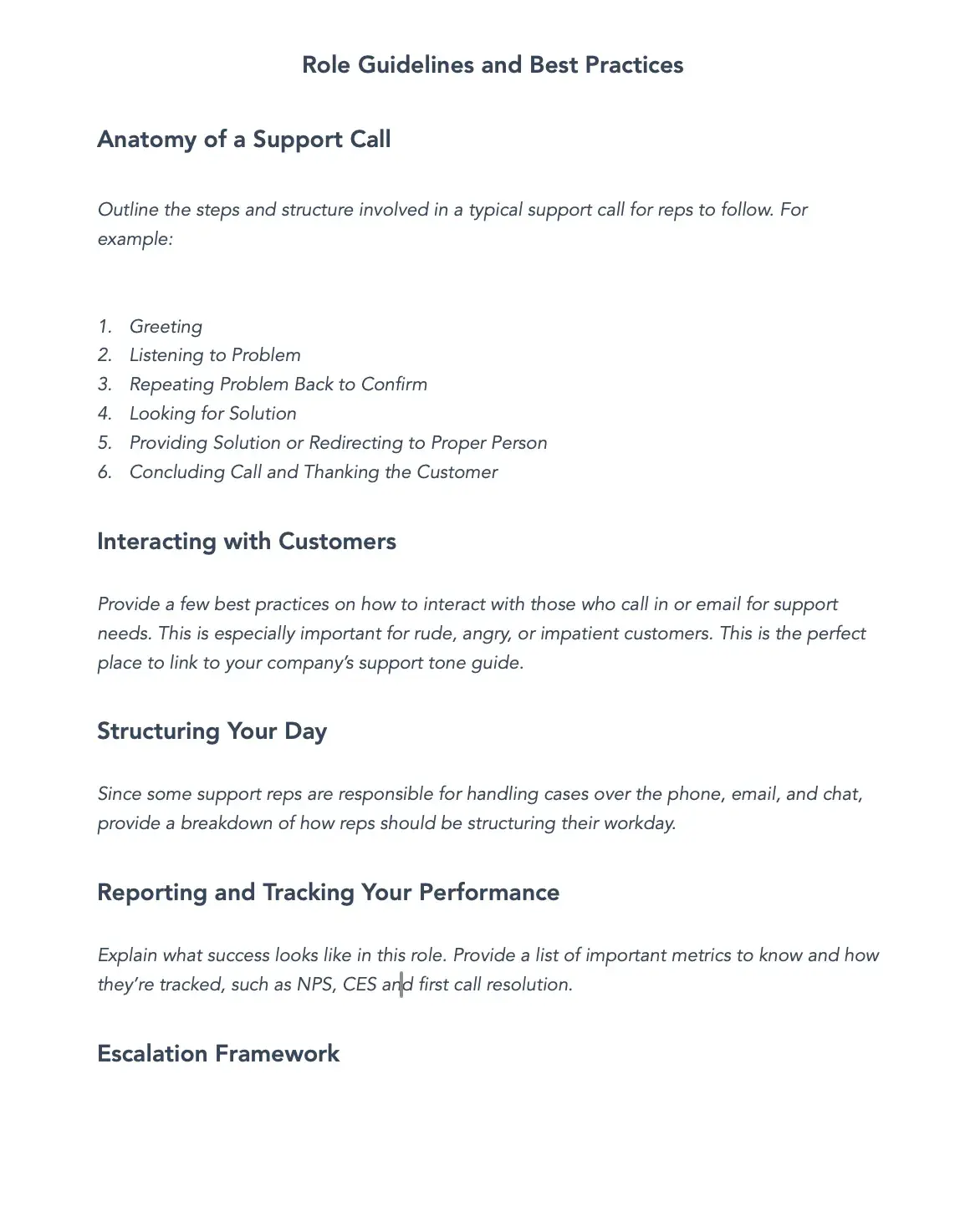

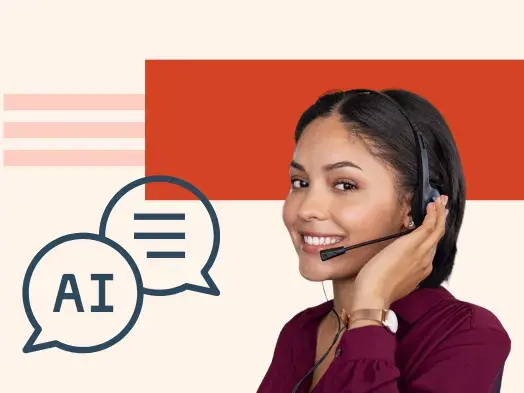
.webp)

